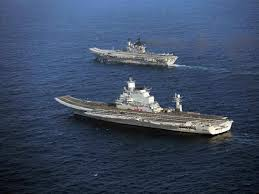Free Courses Sale ends Soon, Get It Now


Free Courses Sale ends Soon, Get It Now



Disclaimer: Copyright infringement is not intended.
Context:
Details:
INS Vikrant
What does INS Vikrant signify?
What is the composition of INS Vikrant?
What are its capabilities?
Chronology of Aircraft Carrier Induction in India:
Significance of Aircraft Carriers:
Future prospects:
INS Vikrant and INS Vikramadiatya:
https://www.iasgyan.in/daily-current-affairs/integration-of-ins-vikrant-and-ins-vikramaditya
Source:
https://pib.gov.in/FeaturesDeatils.aspx?NoteId=151135&ModuleId%20=%202
|
PRACTICE QUESTION Q)Consider the following statements about the capabilities of INS Vikrant, India's first indigenously designed and constructed aircraft carrier: 1. It can operate an air wing of 20 aircraft comprising MiG-29K fighter jets, Kamov-31 helicopters, and indigenous Advanced Light Helicopters. 2. It utilizes the CATOBAR (Catapult Assisted Take-Off But Arrested Recovery) method for launching and recovering aircraft. 3. Its displacement of 43,000 tonnes makes it the third largest among aircraft carriers worldwide. 4. It employs the STOBAR (Short Take-Off But Arrested Recovery) method and can operate an air wing of 30 aircraft comprising MiG-29K fighter jets, Kamov-31 helicopters, MH-60R multi-role helicopters, Advanced Light Helicopters, and Light Combat Aircraft (Navy). How many of the above statement’s is/are correct? A.Only one B.Only two C.Only three D.All four Answer: A Statement 1 is incorrect: ●The correct number of aircraft that INS Vikrant can operate is 30, not 20. The air wing includes a variety of aircraft types, such as MiG-29K fighter jets, Kamov-31 helicopters, MH-60R multi-role helicopters, Advanced Light Helicopters, and Light Combat Aircraft (Navy). Statement 2 is incorrect: ●INS Vikrant employs the STOBAR (Short Take-Off But Arrested Recovery) method, not the CATOBAR method. In the STOBAR method, aircraft take off using a ski-jump ramp and land with the assistance of arresting wires, while in the CATOBAR method, aircraft are launched using catapults and recovered using arresting wires. Statement 3 is incorrect: ●While INS Vikrant has a displacement of 43,000 tonnes, it is not the third largest among aircraft carriers worldwide. It is stated in the passage that INS Vikrant is the seventh largest among carriers or carrier classes in the world. Therefore, this option is inaccurate. Statement 4 is correct: ●INS Vikrantutilizes the STOBAR method for launching and recovering aircraft. Additionally, it can operate an air wing of 30 aircraft, which includes MiG-29K fighter jets, Kamov-31 helicopters, MH-60R multi-role helicopters, Advanced Light Helicopters, and Light Combat Aircraft (Navy). Therefore, this option accurately represents the capabilities of INS Vikrant as described in the passage. |
© 2024 iasgyan. All right reserved